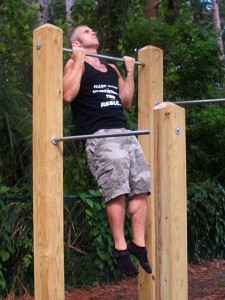Click here to read the original interview on ConditioningResearch.com
Chris Highcock: Normally in these interviews I start off by asking a little about your background: how you got into training and how you developed your particular approach. In your case though your website explains your career in detail and clearly addresses how you have formed your philosophy of training.
It would be lazy to ask you to repeat all that stuff….but just to round out the introduction – there seems to be quite a focus on “bodybuilding”. What first got you interested specifically in bodybuilding as such?
Drew Baye: I’ve always been big fan of action movies, and growing up in the 80’s Sylvester Stallone and Jean Claude Van Damme were my idols. I remember being amazed at how muscular those guys were in movies like Rambo III and Kickboxer and wanting to look like them.
Chris Highcock: Do you still practice any sports – you have mentioned that you used to be involved in martial arts?
Drew Baye: I’ve studied various martial arts over the years, but these days I mostly focus on Wing Chun. I also occasionally practice Parkour with a group in Orlando.
Chris Highcock: Have you trained any athletes that compete in sports?
Drew Baye: While attending college in Green Bay I trained Seth Dittman and Jeff Wilner who played for the Packers at the time. Over the years I’ve also trained a lot of clients who competed or participated in various sports at different levels, always with good results, but most of my clients have been more focused on fat loss or general health and fitness.
Chris Highcock: What are the key factors of importance in training athletes?
Drew Baye: By far the most important factor is increasing an athlete’s resistance to injury. At the very least an injury can interfere with practice and competition, at the worst it can end a career or a person’s ability to perform an activity they’re passionate about. The entire body should be made as strong as possible with special attention to the areas where injuries are most common. For example, everyone involved in any kind of contact sport should perform direct strengthening exercises for the neck.
Everything else – strength, stamina, speed, etc. – is important, but none of it matters if the athlete can’t practice or compete.
Another important factor is making the distinction between training for physical conditioning and practice for improving specific skills and doing each in the most effective manner possible. When you try to combine the two, for example, mimicking a sport movement with a barbell, you end up with a less effective exercise that either contributes nothing to the sport skill being mimicked or can even interfere with the development of that skill.
Chris Highcock: If you’ve read some of my previous interviews you might have noticed that an area that I am particularly interested in is the idea of “functional” or so called sport specific training. Do I take it that you agree with Doug McGuff, John Little and Luke Carlson who explained in their interviews that such an approach is, at best, misguided? They key – they would say – is to strengthen the muscles in the most appropriate effective and efficient way…..and then learn the skills properly to apply that strength.
Drew Baye: They are absolutely correct. Strength training should be performed using movements which are designed to safely and effectively strengthen the major muscle groups. Skill is very specific. To improve your skill in the performance of a particular movement or activity the practice must be as close as possible to the conditions the skill will be used under. When you add a significant amount of weight to the movement you change the balance, the relative contribution of the different muscles involved, and various other factors, and are doing something totally different as far as skill is concerned. There is no transfer of skill between different activities.
Chris Highcock: McGuff and Little’s book Body by Science seems to have reignited interest in HIT principles, at least among the “blogosphere”. You posted a very positive review of the book. Reflecting on it, is there much in there that is truly new, or do you think it has just come along at an opportune time when the internet lets niche markets prosper?
Drew Baye: Nothing in Body by Science is new, but it is currently the best presentation of the information. It provides a clear explanation of the science and how to apply it in one’s workouts.
Chris Highcock: Reading your own material you seem to differ in a few areas from McGuff / Little (e.g. rep speed, frequency of training, routine design) – but only a few. One of these distinctions is rep speed. You have a fascinating article on your site about your experiences with Superslow and your move towards more “conventional” speeds (e.g. two second positive, four second negative) In the scheme of things for the majority, how important are such details, such differences?
Drew Baye: Not very. Details like rep speed, rep range, number and selection of exercises, sets, etc. are important, but people often make them out to be a much bigger deal than they really are. Ultimately, what matters most is that you train hard and progressively in a reasonably safe manner, don’t overtrain, and get adequate rest and nutrition.
Chris Highcock: Following on from that…do you think those of us with an interest in training – even or especially HIT type people – spend too much time obsessing over their training, reading the blogs and forums, analysing the details not the principles? Do we get too “cluttered”?
Drew Baye: The problem isn’t analyzing the details or principles, as long as you take everything you read with a grain of salt. There is a lot of bullshit out there. However, I think a lot of people do this because they think they’re missing some little bit of information or some secret that is going to somehow dramatically change the results they’re getting from their training, when it is usually something as simple as putting more effort into your workouts, cutting back the volume or frequency a little, eating better or getting more rest. For someone having a hard time putting on size, a change in some detail like rep speed or which exercise you’re doing for biceps isn’t going to make the slightest bit of difference compared to getting more quality food.
Chris Highcock: Why is there so much “hate” directed towards HIT? After I posted my interviews of
Doug McGuff and
John Little I saw my blog get described on one forum as “HIT cock sucking”….
Drew Baye: There are a lot of reasons for this, but most of them come down to ego. For many guys, strength training is one of those “manly” things like fighting and sex they think they know something about and have strong opinions on. Especially when strength training, competitive lifting or sports or bodybuilding is a big part of their self-image or identity. Telling a guy like that he is wrong about something exercise related is like calling him a wimp or having sex with his girlfriend and her telling him how much better you are. They don’t tend to take it very well and they react emotionally.
It doesn’t help some proponents of high intensity training have been very abrasive when talking about it. Nobody likes to be insulted or told they don’t know what they’re doing, and Arthur Jones insulted a lot of people and told them just that. Right or wrong, that approach will turn off a lot of people, even turn them against you, regardless of the merits of what you’re saying.
Something I always consider when coaching someone during a workout which applies to communication in general is anything can be phrased positively or negatively. When someone does something incorrectly I can either point out the mistake or I can instruct them on how to correct it. If I say, “your grip is too wide” I’m criticizing. If I say, “move your grip in about two inches” I’m instructing. Same general idea, but it will have a different effect and tend to produce a different response.
I’ve been as guilty of this as anyone, and it’s easy to become frustrated with some people and the things they say and go off on a rant, but I try to be more patient with people these days, especially if they seem sincerely interested in learning.
Chris Highcock: Can we talk about “Metabolic Conditioning”. Crossfit has brought “metcon” into the spotlight and indeed they seem to have coined that abbreviation. You have had some material up on “metcon” building on Brycki’s 3×3 routine . I’ve used with the routine a few times and it is tough.
However, I must admit to still being a bit confused around the principles at play: Where is the “overload” going, the muscles or the “CV system?”
Drew Baye: Both. You can’t separate the two. The cardiovascular system supports the work being performed by the muscles. Although you can emphasize one or the other depending on the method used you can’t perform demanding muscular work without the cardiovascular system being taxed somewhat, and you can’t tax the cardiovascular system without performing muscular work.
Chris Highcock: How do you define metcon?
Drew Baye: Metabolic conditioning, as opposed to cardiovascular conditioning, is the efficiency of energy metabolism in the muscles, as opposed to the efficiency of the cardiovascular system at delivering resources and removing waste to support the muscular work.
Chris Highcock: In the spirit of specificity, does the “fitness” developed by metcon / 3×3 transfer to sports?
Drew Baye: The type of metabolic conditioning developed by 3×3 workouts, old-school Nautilus routines emphasizing rushing between exercises, and similar types of training will benefit an athlete in any sport with a significant metabolic demand, regardless of the specific work, rest intervals of the sport.
Even endurance athletes will benefit from this type of training because the aerobic metabolism is indirectly affected. Doug McGuff covers this in Body by Science in the section on Global Metabolic Conditioning.
Add specific skill training – the ability to efficiently perform the movements of the sport – and the athlete will be able to perform far more work, more quickly, with less wasted energy, while their opponents are sucking wind and struggling just to keep pace.
Chris Highcock: One thing that I notice with HIT style training is that is all seems very serious! This catches me a little. Those into “functional training” look like they are having fun (e.g. the Movnat guy Erwan LeCorre ! Movement, skill based movement, is often just joyous! Jumping rolling, fighting, climbing. How do we balance the need for proper training with the fact that movement is fun and exciting! (I’m asking this having seen YouTube videos of you doing parkour.)
Drew Baye: There’s no reason a person can’t do both, but they shouldn’t try to make their training fun and they shouldn’t ruin the fun of other activities by trying to turn them into workouts. Train in the safest and most effective manner to build strength and conditioning, then put it to good use doing activities you enjoy.
Chris Highcock: Do you see a role for prehab / rehab exercises? For example if you read the blogs of some trainers they make much of shoulder work (YWLT moves, face pulls, external rotation work, stretching etc.) Others go into detail on joint mobility as a panacea for all sorts of problems. Is this just a diversion – an irrelevance for most – or is there a point to it?
Drew Baye: Unless there is a pre-existing problem that requires specific exercises to address, a well-designed routine providing balanced work for all the major muscle groups through a relatively-full range of motion will do everything a person needs.
Ironically, there are trainers who will insist on doing all sorts of prehab or rehab to prevent injury or restore function, but then teach such poor exercise form they’re more likely to injure the trainee than help them. The whole issue is moot if you aren’t teaching proper form to begin with.
Chris Highcock: There is quite a movement out there now around “minimalism” – focussing on the essentials removing clutter (e.g. the Zen Habits blog). Do you think physical training is crying out for minimalism, for stripping out some of the clutter?
Drew Baye: Absolutely. There is so much unnecessary and unfounded complexity in a lot of what’s being promoted as exercise, much of it having to do with people trying to sell you shit you don’t need or convince you their program or products are somehow more scientific and therefore better, that people have lost sight of the basics – hard work and progression.
Most people would get far better results focusing on working hard and progressively on a few basic exercises than following routines requiring them to constantly change set and rep schemes, exercises or movement angles, etc. You don’t need anything fancy to get good results from training – you just have to be willing to work very hard at it on a consistent basis.
Chris Highcock: Much of my training is done at home – commercial gyms are not convenient and it is often difficult to get a decent session in with people hogging machines or chatting. All I really have at home are dumbbells. What scope is there for training productively with only calisthenics and dumbbells?
Drew Baye: You can get tremendous results training with nothing but calisthenics and dumbbells, even if you have a limited amount of weight. The progression is just more complex.
With a barbell, you can increase the resistance by simply adding weight. Although you can add weight to some calisthenics and gymnastic movements like chins, dips, etc., to increase resistance in many movements requires increasing the lever you work against, by progressing to more challenging exercises for a muscle group.
Matt Brzycki and Fred Fornicola ( I interviewed Fred here – CH) wrote a book called Dumbbell Training for Strength and Fitness which I highly recommend for someone who prefers to train with dumbbells. You can read my interview with Fred about the book at https://baye.com/interview-with-fred-fornicola-co-author-of-dumbbell-training-for-strength-and-fitness/
Chris Highcock: One area I struggle to train at home is legs / hips. I can do stiff leg deadlifts….but squatting with dumbbells feels awkward. Do you have any suggestions?
Drew Baye: Hold the dumbbells at your sides like you would for a parallel grip deadlift, rather than overhead or at shoulder height, but use a more upright posture like you would during a squat.
Another option is one-legged squats, or pistols, of which there are numerous variations. They can be performed with dumbbells, which may help if you’re having difficulty maintaining balance.
Chris Highcock: Diet – you have a photo on the blog of your days as a competitive bodybuilder and you were ripped. How did you achieve that condition? How would you replicate it today – what would you do differently?
Drew Baye: Many are going to find this hard to believe, but at that time I was only training once weekly, doing a single set to failure of only six exercises:
- Barbell Stiff-Legged Deadlift
- Hammer Strength Leg Press
- Hammer Strength Pulldown
- Hammer Strength Chest Press
- Hammer Strength Low Row
- Cybex Plate-Loaded Calf Raise
The sets were performed using SuperSlow, ten seconds up, ten seconds down, with a range of four to eight reps. When I hit positive failure I’d continue to push for another 10 seconds or so, and occasionally my trainer, Mike Moran, would apply one or two forced reps or a forced negative. Then he’d rush me to the next exercise. There was zero rest in between. I still remember having to grab other machines for balance while I stumbled from the leg press to the pulldown as quickly as I could manage.
I did absolutely no cardio. Getting ripped was entirely a matter of diet. At the time I used a zone-type diet, but also kept track of calories. I just reduced my calories further for the two months to get into ripped condition. Since one of my photos in ripped condition appeared in Tim Ferriss’ book The 4-Hour Body I’ve received a ton of e-mail about this and wrote an article covering it at https://baye.com/getting-ripped-abs-with-no-direct-abdominal-exercises/
Today, I would do a few things differently. I’d use a more moderate repetition speed and add another upper body pushing exercise to balance out all the pulling. I would also eat a higher percentage of protein and fat on most days, but add more carbs in the meals before and after workouts on training days.
Chris Highcock: Finally, I know that there are a lot of people who read this blog who are not particularly gifted athletes – just average guys with jobs, worries and family responsibilities. What are the key things that they need to know as they try to integrate some training into busy lives?
Drew Baye: Fortunately, it’s not as hard to integrate as many believe because very little time is required for good results if training is done correctly. The most anyone would need to train is half an hour two or three times weekly, and most people can get good results training only twice weekly or less, and depending on individual recovery ability some may do better training even less.
They should train as hard as possible on a few basic exercises covering all the major muscle groups, always trying to do more reps or lift a little heavier weight than they did previously, using strict form. The goal is to stimulate strength increases, not try to see how much weight you can throw up. Think long term, you want to train in a manner that provides the maximum benefit with minimum risk, so you can stay functional and active for your entire life.
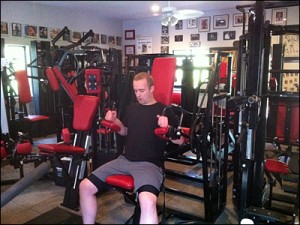 I’m about to leave for a weekend at the beach for our fifth wedding anniversary, so I’m going to keep this brief. There are just a few comments I want to make while they’re on my mind.
I’m about to leave for a weekend at the beach for our fifth wedding anniversary, so I’m going to keep this brief. There are just a few comments I want to make while they’re on my mind.
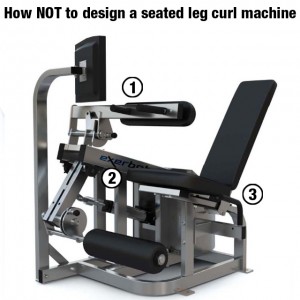

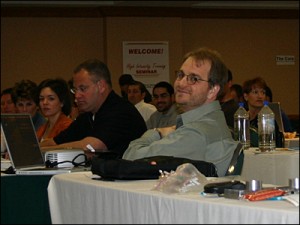






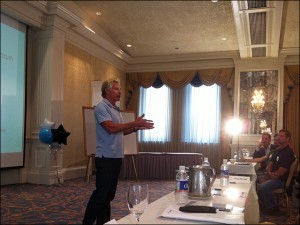
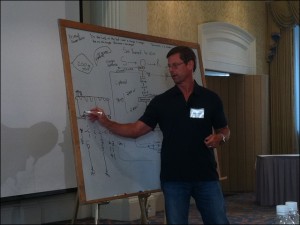

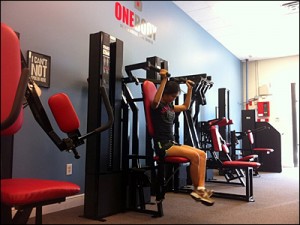
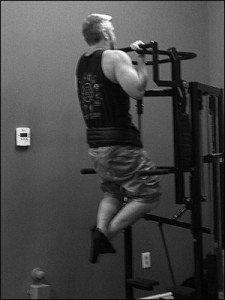 Hard workout today:
Hard workout today: